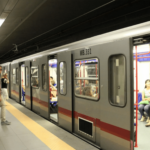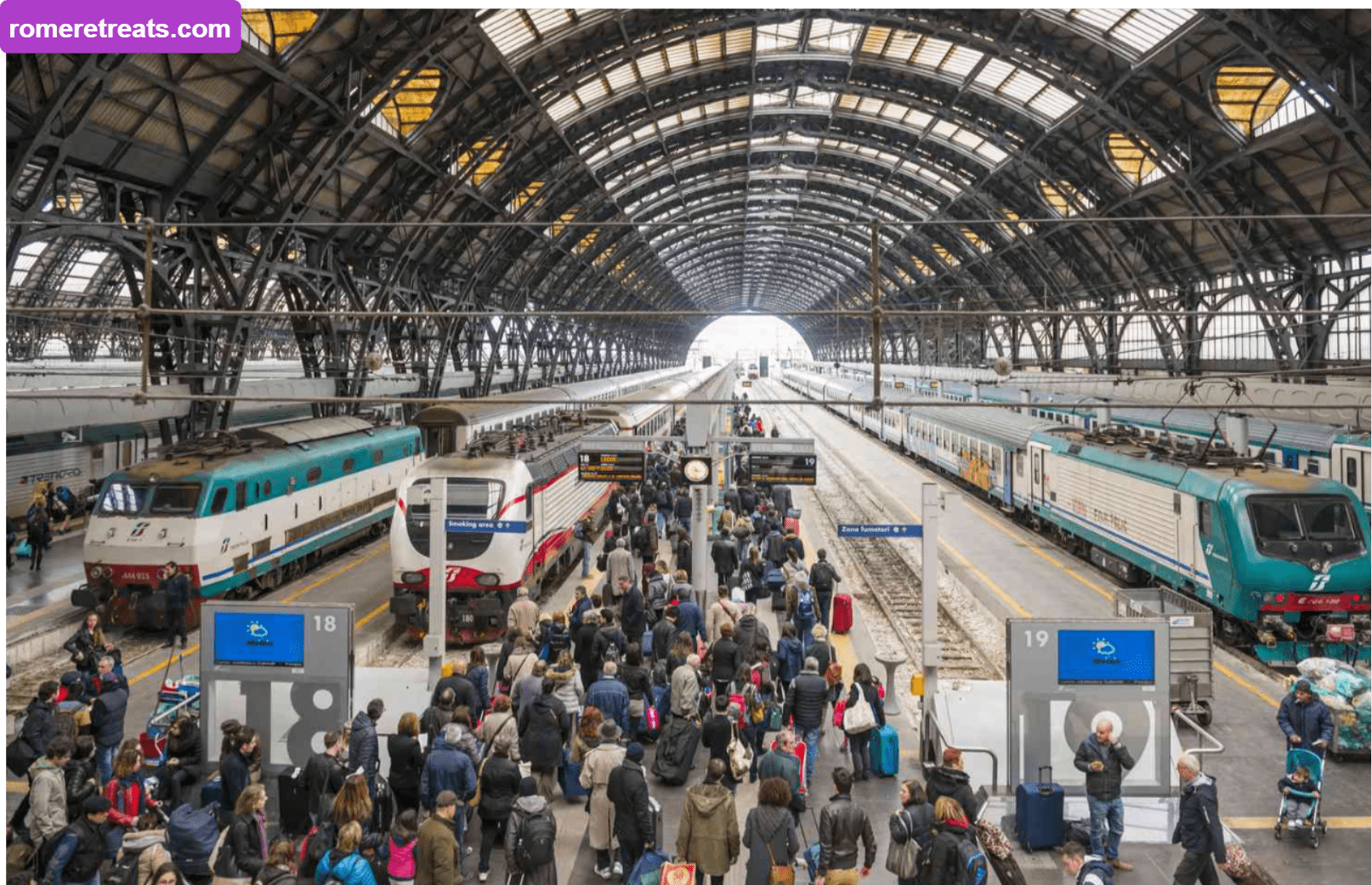Train In Rome: Traveling by train is the most efficient way to get around Rome. By understanding how to use the train system in conjunction with the metro, you can greatly minimize your travel time. Although buses in Rome have their own lanes, they can still get stuck in traffic, whereas trains and the metro offer uninterrupted travel.
Rome features numerous train stations, with several railway lines intersecting throughout the city. This makes using the train a convenient option, especially if you’re staying outside the city center.
For accessing popular districts like Trastevere and the Vatican, trains often provide a quicker alternative to buses. Moreover, mastering the combination of trains, metro, and trams will enhance your ability to explore Rome as if you were a local.
Below, you’ll find a detailed guide to using trains in Rome, including how to purchase tickets, an overview of the major railways, and the key stations that are most relevant for tourists.
Tips for Using the Train System in Rome
Getting Acquainted with Rome’s Train Network
Navigating Rome can be challenging, and the train system in Rome is no different. However, due to its extensive coverage and speed, it’s worthwhile to learn how it works.
Start by getting familiar with the different railways and their routes. Rome has eleven urban railways, each serving different stations, with several lines converging at major hubs like Tuscolana, Tiburtina, Ostiense, Trastevere, San Pietro, and Termini. Keep in mind that urban fares only apply within the city limits of Rome.
Here’s a quick guide to the main railways and their stations:
- FL1: Runs from Orte to Fiumicino Airport, stopping at key stations like Trastevere, Ostiense, Tuscolana, Tiburtina, and Roma Nomentana (near metro B1). The urban fare applies from Fiera di Roma to Settebagni, and the fare to Fiumicino from Rome is €8.
- FL2: Connects Roma Tiburtina with Tivoli. The urban fare is valid from Tiburtina to Lunghezza, with the fare to Tivoli costing €3.
- FL3: Runs from Roma Tiburtina to Viterbo Porta Fiorentina, offering both “regionale” (R) and “regionale veloce” (RV) services. The R service stops at all stations, while the RV service skips smaller stops, halting only at the busier ones like Trastevere, San Pietro, and Valle Aurelia. The urban fare of €1 applies from Tiburtina to Cesano di Roma, with prices increasing beyond that point.
- FL4: Splits into three branches, connecting Roma Termini with Velletri, Albano Laziale, and Frascati. After arriving at Ciampino from Roma Termini, you’ll need to change trains depending on your destination. The urban fare is valid until Capannelle.
- FL5: Links Roma Termini with Civitavecchia, stopping at important stations like Tuscolana, Ostiense, Trastevere, and San Pietro. This line also services beaches near Rome, such as Fregene, Santa Severa, and Santa Marinella.
- FL6: Runs from Roma Termini to Cassino, passing through towns like Anagni and Frosinone, making it ideal for day trips from Rome. The urban fare is valid until Capannelle.
- FL7: Connects Roma Termini with Minturno-Scauri, serving towns in the Lazio region like Formia-Gaeta, Latina, and Fondi-Sperlonga. The urban fare covers the first two stops, ending at Torricola.
- FL8: Operates between Roma Termini and Nettuno, passing through Pomezia, Aprilia, and Anzio. Like the FL7, the urban fare is valid for the first two stops, ending at Torricola.
- Roma-Ostia Lido: Connects Rome with the Ostia beach and the Ostia Antica archaeological site, departing from Roma Porta San Paolo (next to Piramide metro station) and stopping at several urban stations like Basilica di San Paolo, EUR Magliana, Acilia, and Castel Fusano before reaching Cristoforo Colombo. The urban fare is applicable for the entire route.
- Roma-Civita Castellana-Viterbo: This line has two routes departing from Flaminio in the city center, one urban and one extending to Viterbo. The urban route runs from Flaminio to Montebello, with the urban fare covering this entire section. The extra-urban route continues to Viterbo, stopping at towns such as Sacrofano, Castelnuovo di Porto, Morlupo, Fabrica di Roma, Corchiano, and Vitorchiano. The urban fare applies from Flaminio to Sacrofano.
- Termini Laziali-Centocelle: An urban route connecting Roma Laziali (near Roma Termini train station) with Centocelle, stopping at stations like Porta Maggiore, Ponte Casilino, and Tor Pignattara.
Key Train Stations in Rome
Rome has numerous train stations that offer easy access to central landmarks, either by foot or by combining various forms of public transportation. Some of the most frequented stations include:
- Roma Termini: The primary train station in Rome, serving as a major bus hub and the intersection of metro lines A and B. From Termini, you can catch high-speed trains to other cities and regions, as well as urban trains to other stations within the city. It’s also a preferred station for catching the Leonardo Express to Fiumicino Airport.
- Roma Trastevere: Popular for its proximity to the Trastevere neighborhood. From here, you can reach the tourist areas with a few tram stops or a 20-minute walk. Trains to Fiumicino also depart from this station.
- Roma Ostiense: A busy station that serves a variety of urban, regional, and national trains. It’s situated in the heart of the Ostiense neighborhood, close to Testaccio and Garbatella.
- Roma San Pietro: An important station due to its proximity to Vatican City. From here, you can easily reach St. Peter’s Basilica by exiting at Piazza della Stazione di San Pietro or by taking the scenic “Passeggiata del Gelsomino” from platform 1, which leads to the back of the Basilica.
- Valle Aurelia: Popular with locals for trains to Cesano, Bracciano, Viterbo, and other towns north of Rome. It’s also connected to metro line A. Valle Aurelia is a convenient area to stay, offering easy access to central Rome, good public transport connections, and plenty of shops, restaurants, a gym, and a shopping mall.
Popular Train and Metro Combinations in Rome
Several train stations in Rome are conveniently located near metro lines A or B, allowing for easy access to significant landmarks and accommodations. Here are some popular train and metro combinations for tourists:
- Colosseo (metro B): Accessible from Ostiense train station (Piramide metro).
- Ottaviano and Cipro (metro A): Near the Vatican, reachable from Valle Aurelia train station.
- Flaminio (metro A): Near Piazza del Popolo and the historic center, also close to Flaminio train station on the Roma-Civita Castellana-Viterbo line.
- Roma Termini (metro A and B): Reachable from various train stations across the city, including Stazione San Pietro, Trastevere, Ostiense, Tuscolana, and Tiburtina.
Types of Tickets for Rome’s Trains
When traveling by train in Rome, you have two main ticket options: Trenitalia tickets or Atac tickets. Atac tickets cover trains as well as all other public transportation in Rome, including the metro, buses, and trams. Trenitalia tickets, however, are only valid for the railway system and do not cover other modes of transport.
For instance, if you’re at Termini and want to travel to Stazione San Pietro before walking to the Vatican, you can purchase a €1 Trenitalia ticket through the app, as you’ll only be using the train.
However, if you’re at Trastevere station and need to get to the Colosseum, you could take the train to Ostiense and then transfer to metro line B at Piramide for two stops. In this case, a Trenitalia ticket alone wouldn’t be sufficient; you’d need to buy a €1.50 Atac ticket, which covers both the train and the metro.
If you’re planning to stay in Rome for several days and expect to use public transport frequently, consider purchasing a 24-hour, 48-hour, or 72-hour ticket, which covers trains, metro, buses, and trams for all routes within the municipality and urban fare.
How to Buy Train Tickets in Rome
There are multiple ways to purchase tickets for train in Rome, whether at the station or online. Here’s how:
At the Train Station
Ticket offices with staff are usually found in larger stations, but every station, including smaller ones, has ticket machines. These machines allow you to purchase any type of ticket, whether for traveling to other cities or for urban train routes.
Note that these vending machines are from Trenitalia and do not sell Atac tickets.
At the Metro Station
Metro stations have Atac ticket machines that sell only Atac tickets. The single €1.50 tickets are valid for 100 minutes and cover one train ride, one metro ride, and unlimited bus rides within that time frame.
Online and Through an App
Purchasing train tickets online is often the most convenient option, especially if you’re
buying them in advance or outside Italy. Websites like Trainline, Omio, and Italo allow you to purchase tickets directly and offer mobile ticketing options.
Alternatively, you can download the Trenitalia app to buy tickets. You can also purchase Atac tickets via the “My Atac” app or by sending a text message with the word “BIT” to 48018. Be aware that a small fee applies when purchasing tickets via SMS.









